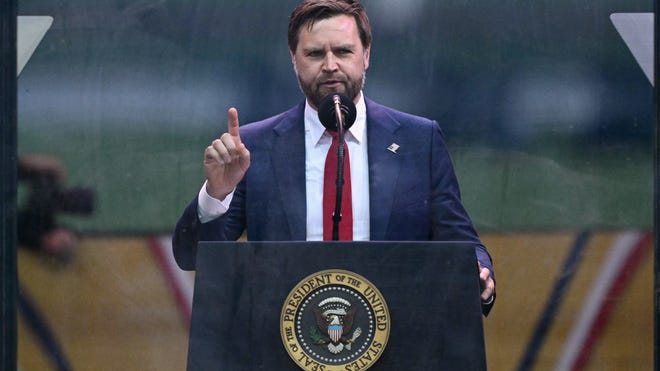JD Vance, the Vice President, indicated on a Sunday that despite the recent surprise attack on three Iranian nuclear facilities, the United States is not in direct conflict with Iran, but with its nuclear program. ‘Iranians have exhibited a lack of martial prowess. They would do well to adopt President Trump’s peaceful outlook,’ declared Vance. He further assured that if Iran were sincere in seeking peace, the United States president would reciprocate that sentiment.
The Defense Secretary, Pete Hegseth, also confirmed during a Sunday press conference at the Pentagon that the U.S. does not intend to instigate war. Reinforcing Vance’s sentiment, he expressly stated that any mission is aimed at curtailing Iran’s nuclear program, not changing the regime. ‘Operation Midnight Hammer,’ intended to function with decoys and deception, incurred no resistance from Iran.
During the press conference, Hegseth, along with Air Force Gen. Dan Caine, the Chairman of the Joint Chiefs of Staff, remarked the operation was successful. The nuclear sites in Fordo, Natanz, and Isfahan were all essentially incapacitated. Caine stated that the complete assessment of the operation’s outcome would take time. Still, initial reports suggest severe damage and destruction of the three targeted sites.
In response to the attacks, Iran’s Foreign Minister Abbas Araghchi stated that the United States must bear complete responsibility for any subsequent action taken by Iran. During a press conference in Turkey, he remarked, ‘The U.S. has crossed a substantial red line by attacking nuclear facilities. I remain uncertain about where this leaves diplomatic proceedings.’
Secretary of State Marco Rubio echoed his counterparts’ sentiments, emphasizing there were no forthcoming military operations against Iran, unless provoked by an attack on U.S. interests. As the news of the strikes began to permeate, concerns arose about their potential to instigate more conflicts throughout the Middle East, particularly due to America’s intervention in the ongoing Israel-Iran dispute.
The Israeli air attacks that began on June 12 targeted Iran’s nuclear facilities and top military personnel, prompting strong retaliation from Iran and subsequent U.S. confrontations. This escalated situation attracted international attention and condemnation from China and Russia, both accusing the U.S. military of inappropriate action.
Following the escalated situation, Britain’s Prime Minister, Keir Starmer, stated that the UK was strategically moving military equipment to safeguard its people, interests, and allies while simultaneously pursuing a diplomatic solution. Simultaneously, leaders from Italy, Canada, Germany, and France called for swift recommencement of negotiations, highlighting the urgency to establish peace.
Iran’s reaction could significantly influence oil exports via the Strait of Hormuz, resulting in inflationary consequences. The Israel-Iran clashes have already caused oil prices to surge by 21% in the preceding month in international markets, signifying potential economic impacts.
Despite these geopolitical tensions, Vance expressed confidence in America’s ability to considerably slow Iran’s nuclear weapon development. He pointed out that the U.S. had engaged in robust negotiations and had been indirectly approached by Iran since the attacks, indicating potential communication pathways.
Hegseth further elaborated on the increased protection measures in the local region, specifically in Iraq, Syria, and the Persian Gulf. A U.S. military-directed Middle Eastern maritime center issued a high-risk warning to U.S.-associated ships following the American operations on Iranian nuclear sites.
According to Hegseth, President Trump’s imposed timeline encapsulated the period reserved for negotiations with Iran regarding its nuclear ambitions. He clarified that Iran learned that when Trump proposes a peace and negotiation period lasting 60 days, he fully intends to abide by it.
The United States took advantage of the weakened Iranian air defenses to execute the operations without any resistance. Hegseth added that several B-2 bombers were used as decoys as part of a more extensive deception strategy. The missions were carried out between 6:40 pm and 7:05 pm on a Saturday in Washington, D.C., which corresponded with 2:10 am on Sunday in Iran.

